Our website is not supported on this browser
The browser you are using (Internet Explorer) cannot display our content.
Please come back on a more recent browser to have the best experience possible

Several studies over the years have outlined the relationship between improving PM capability and improved business outcomes. Even governments have gotten in on the action, requiring agencies to “propose a target level of capability based on their strategic priorities and for this to be independently validated, before undertaking major projects that receive proposal funding”.
Though there are many ways to improve delivery capability, many government entities have selected P3M3® as the common framework or maturity model for assessing project, program and portfolio maturity. And so can you.
P3M3®, trademarked by Axelos, stands for the Portfolio, Program, and Project Management Maturity Model. You often hear the mantra people, process, tools. A maturity model is used to look across an organization, its people, process and tools, to understand their ability, or capability of delivering on its programs and portfolios.
"P3M3 is a management maturity model that looks across an organization at how it delivers its projects, programmes and portfolios."
Axelos
P3M3® is not specific to methodology being used by the organization. It complements best practice guidance like PRINCE2, Managing Successful Programmes (MSP®), and Portfolio, Programme and Project (P3O®).
The basis for P3M3® is the Capability Maturity Model (CMM) developed by Carnegie Mellon University’s Software Engineering Institute. Therefore, it even complements those organizations using Project Management Institute (PMI) methodologies.
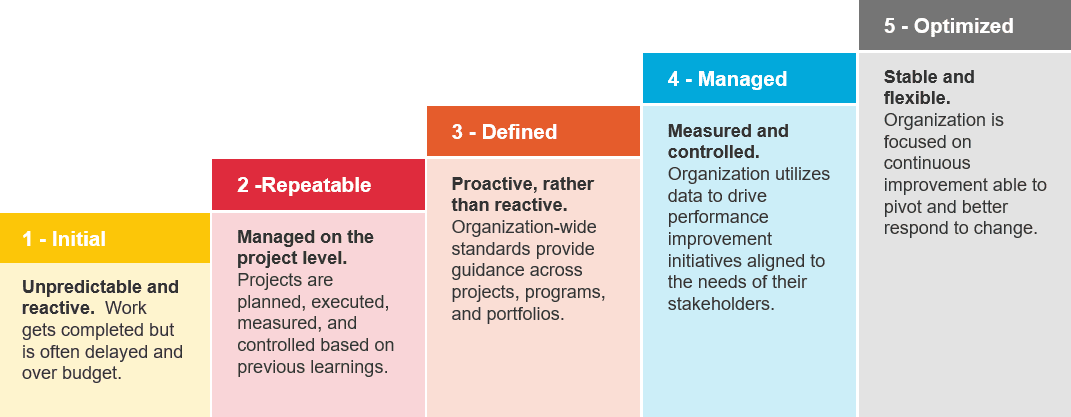
It uses the same five maturity levels, from level one – having an awareness of the processes, or Initial – to level five – the processes being optimized. The P3M3® model, however, focuses on capability maturity across three different areas: Portfolio Management, Program Management and Project Management.
Although connected, there are no interdependencies between these assessments; so an independent assessment can be carried out in any of the specific P3M3® disciplines.
At each level, project, program and portfolio, the organization is measured in seven different areas: management control, benefits management, risk management, stakeholder management, financial management, resource management and organizational governance.
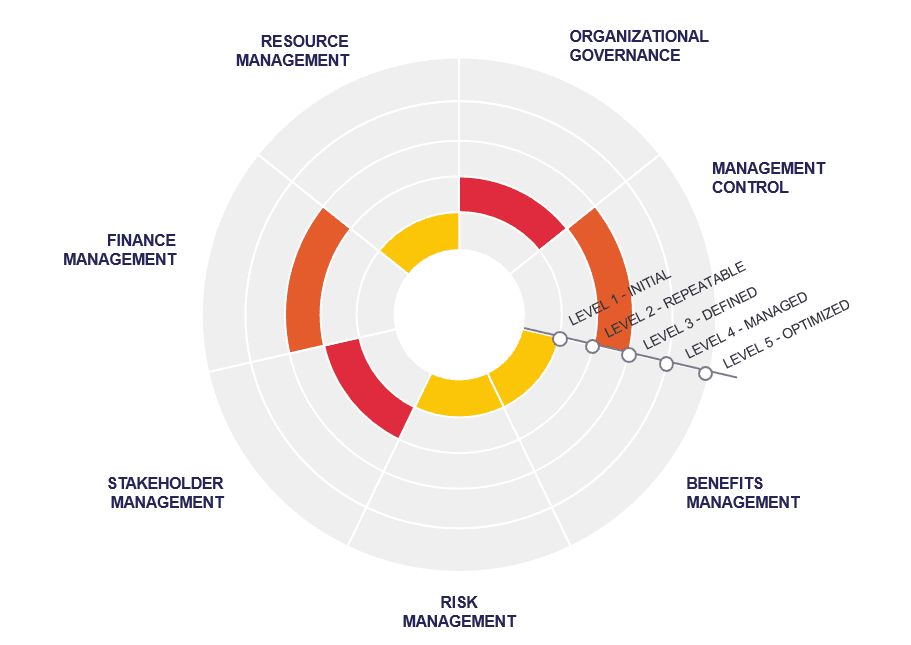
For each area, the model describes a set of specific attributes it would expect to see at different levels of maturity. For example, if an organization were at Level Three (Defined) in the Portfolio model, it would have a “centrally defined, owned, and managed process for translating policy and strategic priorities into portfolio initiatives, with redundant initiatives eliminated”.
All models also share a common set of generic perspectives at each level of maturity. For example if an organization were at Level Four (Managed), it would have “reviews [that] focus on opportunities to improve as well as compliance.”
By reviewing the P3M3® model, organizations can determine which generic and specific attributes best characterize the way they currently manage projects, programs, and portfolios to determine their baseline maturity by the different process perspectives.
This, of course, determines the as-is situation. But as we will explain shortly, the model can also be used to determine what’s needed to gain greater maturity and how to get there.
A number of studies including the most recent PMI Pulse of the Profession (2020), Ahead of the Curve: Forging a Future-Focused Culture; outline the relationship between improving PM capability and improved business value and outcomes.
Those organizations with high maturity are 21% more likely to meet the goals and intent of their strategic initiatives, i.e. improved outcomes, than those organizations with low project management maturity.
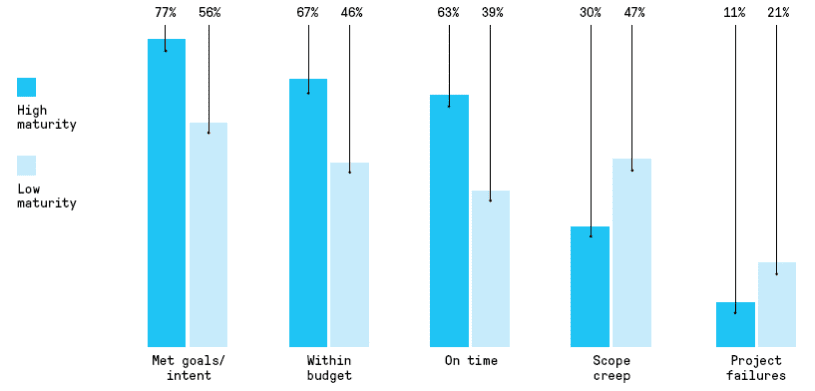
Specific outcomes include a number of tangible and intangible benefits:
If we accept that improving project, program, and portfolio management maturity increases business value, how do you do it?
Succeeding in any change initiative involves base-lining where you are, deciding where you want to be, and figuring out how to get there. Improving delivery capability is no different. We will talk you through the three phased approach below:
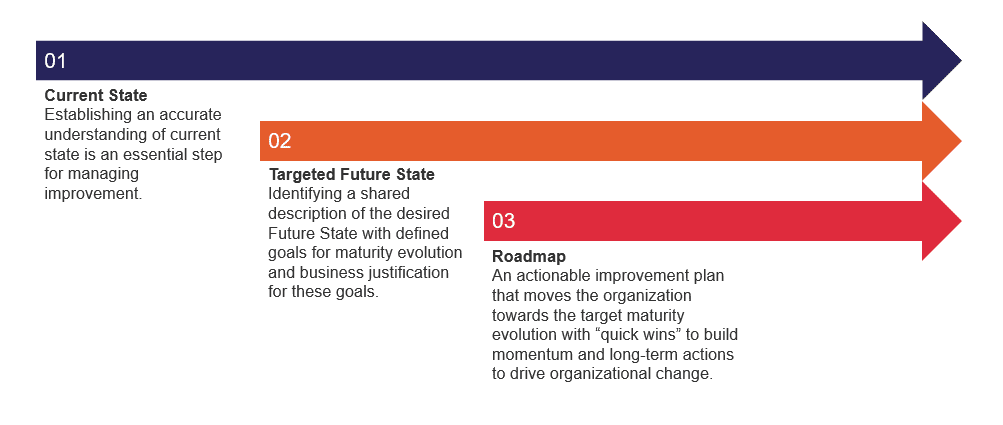
There are a number of ways to determine your current maturity level. The P3M3® model itself, which is freely available, can be used to review your own organization’s characteristics against the attributes in the model and thus determining a current maturity level. Axelos also publishes a self assessment tool for gaining insight as to your current level directly on their site.
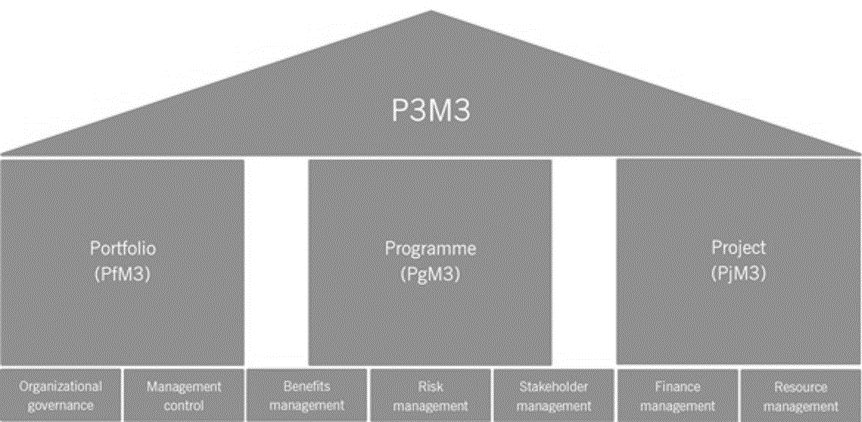
The third more rigorous and ultimately more effective approach is to use an Accredited Consulting Partner (ACP), yes we are one, to facilitate a full assessment. ACPs come equipped with tools, experienced qualified consultants, and a best practice processes for carrying out these assessments.
This provides a more objective and independent approach to the assessment. Typically this involves a Registered Consultant (RC) interviewing a range of project, program, and portfolio management stakeholders to gather evidence around key processes, toolkits, templates, reports from previous reviews, meeting minutes, and a random sampling of selected program documentation.
ACOs bring a wealth of real-world experience to bear on these assessments and typically include knowledge transfer embedded as part of the engagement.
Should you decide to take on a P3M3® maturity level assessment, here are three key elements to consider:
Undertaking the assessment requires clear objectives, senior management commitment, engagement, effective planning, and strong leadership. In other words, it’s a project in itself. Manage it as so.

The P3M3® assessment should always be presented to stakeholders in the context of organizational capability improvement, rather than obtaining a score. There is a danger the assessment can be seen by stakeholders as a “performance appraisal” when it is not looking at personal competence but rather organizational capability.
In this situation, what often manifests itself, is an inflated perception of capability – known as “optimism bias.” To combat this, clearly communicate the purpose of the assessment, the importance of objectivity, what each of the maturity levels mean, and where most equivalent organizations fall (Level 2 or lower).
Finally, just as there is a range of stakeholders involved in project, program, and portfolio management, there should be an equivalent range of participants involved in the assessment.
It is understandable that one would want to focus in on the project managers to understand their capabilities, however as highlighted by the seven perspectives diagram above, the maturity assessment touches on many aspects including organizational governance and related processes. Therefore, participants from the business division, sponsors, customers, portfolio managers, and program managers should all be included.
With the baseline capability set, the next step is to define the target capability level. One’s capability target, as with any performance target, should be pragmatic, considered, and obtainable.
The primary driver for success in improving PM capability is the organization’s ability to adopt and embed change (people, organizational, process, and tools). It should be achieved incrementally, setting achievable targets and building on these once this capability level has been achieved.
It should be noted that very few organizations reach level 4 or level 5 capability. There is a trade-off between the cost of poor project performance (which reduces as maturity increases) and the cost of implementing improvements (which increases as maturity increases).
When setting targets you typically need to consider three dimensions:
Having set a target, the next step is to build a capability improvement roadmap. Many organizations make the mistake of sending their staff off to project management courses and getting them certified in Prince2 or MSP®, or deploying an enterprise project management solution, in the mistaken belief this is enough get them to the next maturity level. This is focusing on the people or the tools alone and is too simplistic of a view.
Having already done the hard work of establishing target levels for improvement, break down your target levels into specific actions against each of the areas of risk, stakeholder management, resource management, etc.
Using this approach, high-level work packages can then be sequenced as quick-win, short-term, or medium-term objectives. The activities, risks, dependencies, effort and cost should be detailed for each work package, which can then be used as the basis for developing the project brief or business case.
As we highlighted with the assessment, it’s important to treat the follow on capability improvement initiatives as projects themselves. Significant investment will be required, with senior departmental buy in and a focused, on-going commitment to change.
Nothing will change and no benefits will be received without implementation. Here is where an ACP’s skills and experience can assist, particularly with how to handle implementation of the roadmap alongside your existing portfolio of work and training and development commitments.
This article was written by David Wells and has been updated to reflect the latest versions of the P3M3 model and market trends.
More on the same subject
Loved what you just read?
Let's stay in touch.
No spam, only great things to read in our newsletter.
We combine our expertise with a fine knowledge of the industry to deliver high-value project management services.
MIGSO-PCUBED is part of the ALTEN group.
Find us around the world
Australia – Canada – France – Germany – Italy – Mexico – The Netherlands – Portugal – Romania – South East Asia – Spain – Switzerland – United Kingdom – United States
© 2024 MIGSO-PCUBED. All rights reserved | Legal information | Privacy Policy | Cookie Settings | Intranet
Perfect jobs also result from great environments : the team, its culture and energy.
So tell us more about you : who you are, your project, your ambitions,
and let’s find your next step together.
Dear candidates, please note that you will only be contacted via email from the following domain: migso-pcubed.com. Please remain vigilant and ensure that you interact exclusively with our official websites. The MIGSO-PCUBED Team
Choose your language
Our website is not supported on this browser
The browser you are using (Internet Explorer) cannot display our content.
Please come back on a more recent browser to have the best experience possible
